|
|
Post by pjotr on Feb 18, 2013 19:03:54 GMT 1
Kresy Lwów, just before the war, when it was stil PolishKresy Wschodnie Lwów, just before the war, when it was stil PolishKresy Wschodnie or Kresy (Polish pronunciation: [ˈkrɛsɨ], " Eastern Borderlands", or " Borderlands") is a former territory of the eastern provinces of Poland. These territories today lie in western Ukraine, western Belarus, as well as eastern Lithuania, with such major cities, as Lwów, Wilno, and Grodno. This territory was included within the Polish-Lithuanian Commonwealth and the Second Polish Republic, until World War II. In the interbellum Poland, the term Kresy roughly equated with the lands beyond the Curzon Line, suggested in December 1919 by the British Foreign Office as the eastern border for Poland. In September 1939, after the Molotov–Ribbentrop Pact, these territories were incorporated into the Soviet republics of Ukraine, Belarus and Lithuania. These Soviet gains were ratified by the Western Allies at the Tehran conference, the Yalta conference and the Potsdam conference. When the Soviet Union broke up, they remained part of those respective republics as they gained independence. Even though Kresy, or the Eastern Borderlands, are no longer Polish territories, the area is still inhabited by a significant Polish minority, and the memory of a Polish Kresy is still cultivated. The attachment of the " myth of Kresy", the vision of the region as peaceful idyllic rural land, has been criticized in Polish discourse. Economically the region was the poorest in interwar Poland, and had the lowest literacy level of the nation, which was the result of more than one hundred years of Austro-Hungarian and Russian rule, as education was not compulsory in the Russian Empire.  Polish Wilno before the Second World War Polish Wilno before the Second World War Grodno before the war  Grodno before the war Grodno before the war
|
|
|
|
Post by pjotr on Feb 18, 2013 19:04:53 GMT 1
 The history of Lwów The history of Lwów Town hall in Lviv, Ukr.Lviv Town hall in Lviv, Ukr.Lviv, Polish Lwów, German Lemberg, Russian Lvov, city, western Ukraine, on the Roztochchya Upland. Founded in the mid-13th century by Prince Daniel Romanovich of Galicia, Lwów (Lviv) has historically been the chief centre of Galicia, a region now divided between Ukraine and Poland. Its position controlling east-west routes and passes across the Carpathians has given it a stormy history. Polish control was established in 1349. The town was seized briefly by the Cossacks in 1648 and the Swedes in 1704. It was given to Austria on the first partition of Poland in 1772 and occupied by Russia in 1914–15. The government of the short-lived Western Ukrainian National Republic arose in Lviv in 1918, but the Poles drove Ukrainian troops out of the city and regained control. Lwów was seized by the Soviet Union in 1939 and, after German occupation, annexed by the Soviets in 1945. 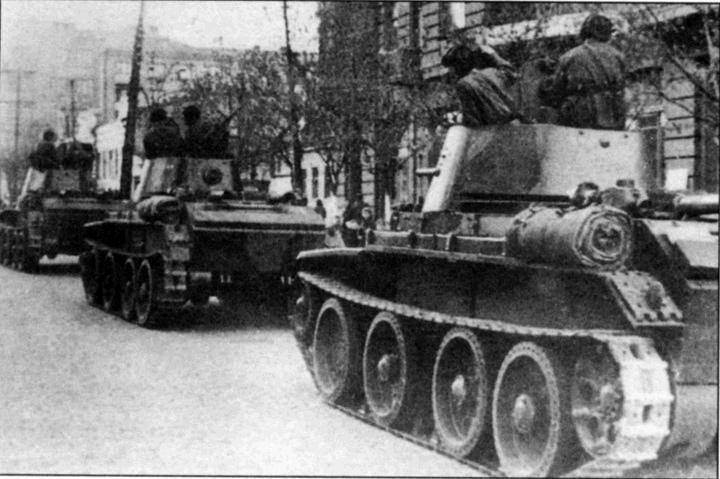 Soviet tanks entering Lvov, 22nd Sept. 1939 Soviet tanks entering Lvov, 22nd Sept. 1939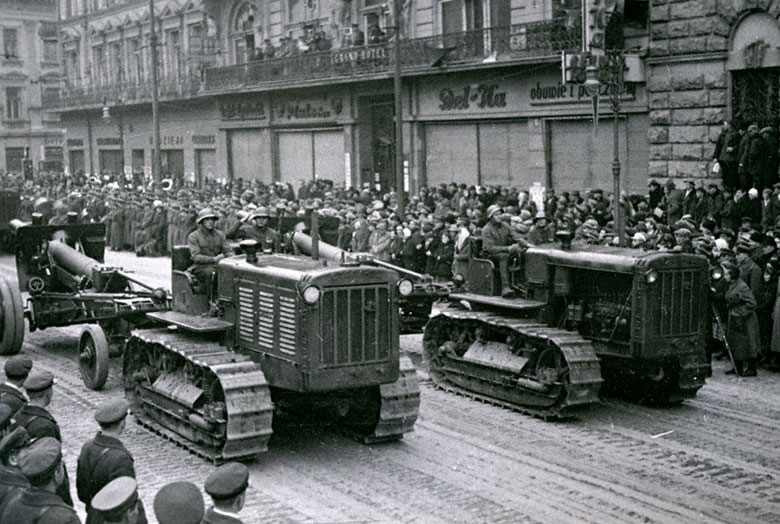 Soviet troops entering Lvov, 22nd Sept. 1939 Soviet troops entering Lvov, 22nd Sept. 1939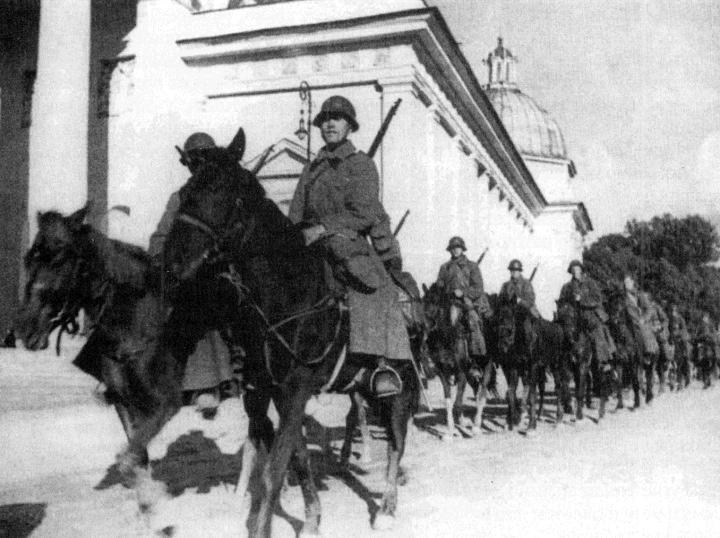 Soviet cavalry in WilnoComment Pieter Soviet cavalry in WilnoComment Pieter: The Sovjets called the city Lviv and the name of the city today is stil Lviv. Ofcourse there lives a considerable Polish minority in Western-Ukraine, and Polish history, culture and historical marks (architecture of buildings, scultptures, art and etc.) will be present there (I presume).  Maria Konopnicka, sculpture on her headstone in Lviv, Ukr. Maria Konopnicka, sculpture on her headstone in Lviv, Ukr.Modern Lviv retains its nodal position, with several railways converging on the city. As a result, industrial development has been considerable: engineering products manufactured in the city have included buses, agricultural machinery, loading machinery, bicycles, and television sets; there are also consumer goods and foodstuffs industries. Lviv is a major publishing and cultural centre, especially of Ukrainian culture, which flourished there in tsarist times when it was suppressed in Russian Ukraine. The university, which was founded in 1661 and named for the Ukrainian poet and journalist Ivan Franko under the Soviet regime, is one of the institutions of higher education and research in the city. Pop. (2001) 732,818; (2005 est.) 733,728.  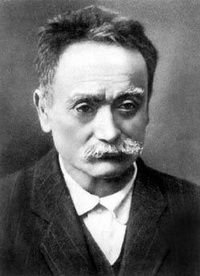 Ukrainian poet and journalist Ivan FrankoSource Ukrainian poet and journalist Ivan FrankoSource: Encyclopaedia britannicawww.britannica.com/EBchecked/topic/352437/LvivLwów during the Interbellum periodIn the interbellum period Lwów (Lviv today) held the rank of Poland's third most populous city (after Warsaw and Łódź) and became the seat of the Lwów Voivodeship. Right after Warsaw, it was the second most important cultural and academic centre of interwar Poland. In the academic year 1937–38 there were 9,100 students attending 5 higher education facilities including the renowned university and institute of technology. In 1920 professor Rudolf Weigl of the Lwów University discovered the vaccine against typhus. The major trade fair called Targi Wschodnie was established 1921. Its geographic location gave it an important role in stimulating international trade and fostering city's and Poland's economic development.  Polish biologist Rudolf Stefan Weigl (September 2, 1883 – August 11, 1957, Zakopane) Polish biologist Rudolf Stefan Weigl (September 2, 1883 – August 11, 1957, Zakopane)  National University Lviv National University LvivWhile the eastern part of the Lwów Voivodeship had a relative Ukrainian majority in most of the rural areas the city itself did not (see table to the right). Prewar Lviv (Lwów) had also a large and thriving Jewish population. The Polish inhabitants of the city spoke the characteristic Lwów dialect. Although Polish authorities obliged themselves internationally to provide Eastern Galicia with an autonomy (including a creation of a separate Ukrainian university in Lviv) and even though in September 1922 adequate Polish Sejm's Bill was enacted, it was not fulfilled. Instead, the Polish government closed down many Ukrainian schools that had previously flourished during Austrian rule and closed down every Ukrainian university department at the University of Lviv with the exception of one. Unlike in Austrian times, when the size and amount of public parades or other cultural expressions corresponded to each cultural group's relative population, the Polish government emphasized the Polish nature of the city and limited public displays of Jewish and Ukrainian culture. Military parades and commemorations of battles at particular streets within the city, all celebrating the Polish forces who fought against the Ukrainians in 1918, became frequent, and in the 1930s a vast memorial monument and burial ground of Polish soldiers from that conflict was built in the city's Lychakiv Cemetery. The Polish government fostered the idea of Lviv as an eastern Polish outpost standing strong against eastern " hordes." |
|
|
|
Post by pjotr on Feb 18, 2013 19:05:48 GMT 1
The Polish history of GrodnoGeneral history Hrodna (Grodno) in Belarus todayHrodna Hrodna (Grodno) in Belarus todayHrodna, also spelled Grodno, city and administrative centre, western Belarus. It is located on the Neman River, close to the borders of Poland and Lithuania (about 20 km and 30 km away respectively). First mentioned in 1128 as the seat of a princedom, Hrodna has had a stormy history, being sacked by the Tatars in 1241 and by the Teutonic Knights in 1284 and 1391. It passed to Lithuania in the 13th century and later to Poland, reverting to Russia in 1795; it was under Poland from 1921 to 1939. Among relics of Hrodna’s past are the ruins of the castle (1580) of the Polish king Stephen Báthory and of an 18th-century castle. Modern Hrodna is a major industrial centre, especially for fertilizers, synthetic fibres, and numerous consumer goods. The town has medical, agricultural, and teacher-training institutes. Grodno has 327,540 inhabitants ( 2009 census). It is the capital of Grodno Region ( voblast) and Grodno raion ( district).  Hrodna todayMedieval origin Hrodna todayMedieval origin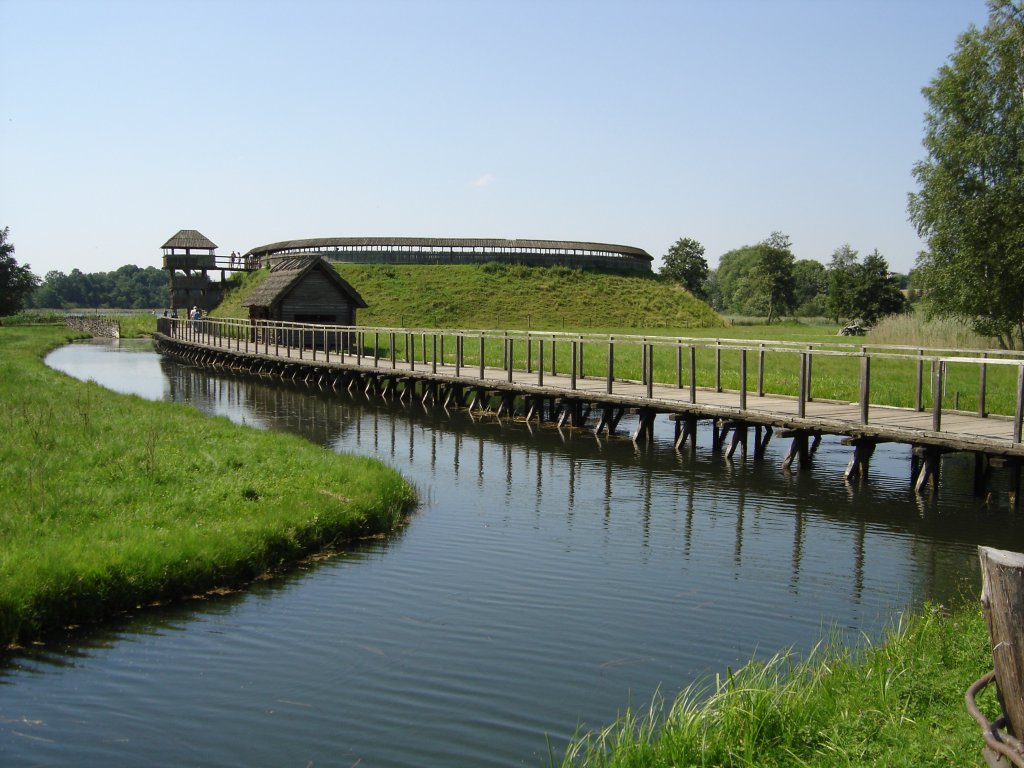 West Slavic fortified settlement (gord) West Slavic fortified settlement (gord)The modern city of Grodno originated as a small fortress and a fortified trading outpost maintained by the Rurikid princes on the border with the lands of the Baltic tribal union Yotvingians. Its name derives from the Old East Slavic verb gorodit', i.e., to enclose, to fence (see "grad" for details). Mentioned in the Primary Chronicle under 1127 as Goroden' and located at a crossing of numerous trading routes, this Slavic settlement, possibly originating as far as the late 10th century, became the capital of a poorly attested but separate principality, ruled by Yaroslav the Wise's grandson and his descendants.  Orthodox church of Sts. Boris and Gleb (12th century) Orthodox church of Sts. Boris and Gleb (12th century)Along with Navahrudak, Hrodna was regarded as the main city on the far west of so-called Black Ruthenia, a border region that neighboured the original Lithuania. It was often attacked by various invaders, especially the Teutonic Knights. In the 1240-1250s the Grodno area, as well as the most of Black Ruthenia, was controlled by princes of Lithuanian origin (Mindaugas and others) to form the Baltic-Slavic state - Grand Duchy of Lithuania on these territories. After the Prussian uprisings a large population of Old Prussians moved to the region. The famous Lithuanian Grand Duke Vytautas was the prince of Grodno from 1376 to 1392, and he stayed there during his preparations for the Battle of Grunwald (1410). Since 1413, Grodno had been the administrative center of a powiat in Trakai Voivodeship. 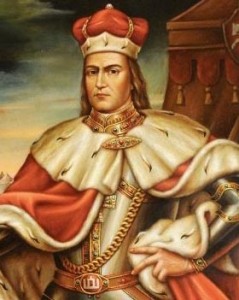 Grand Duke Vytautas the GreatThe Polish history Grand Duke Vytautas the GreatThe Polish history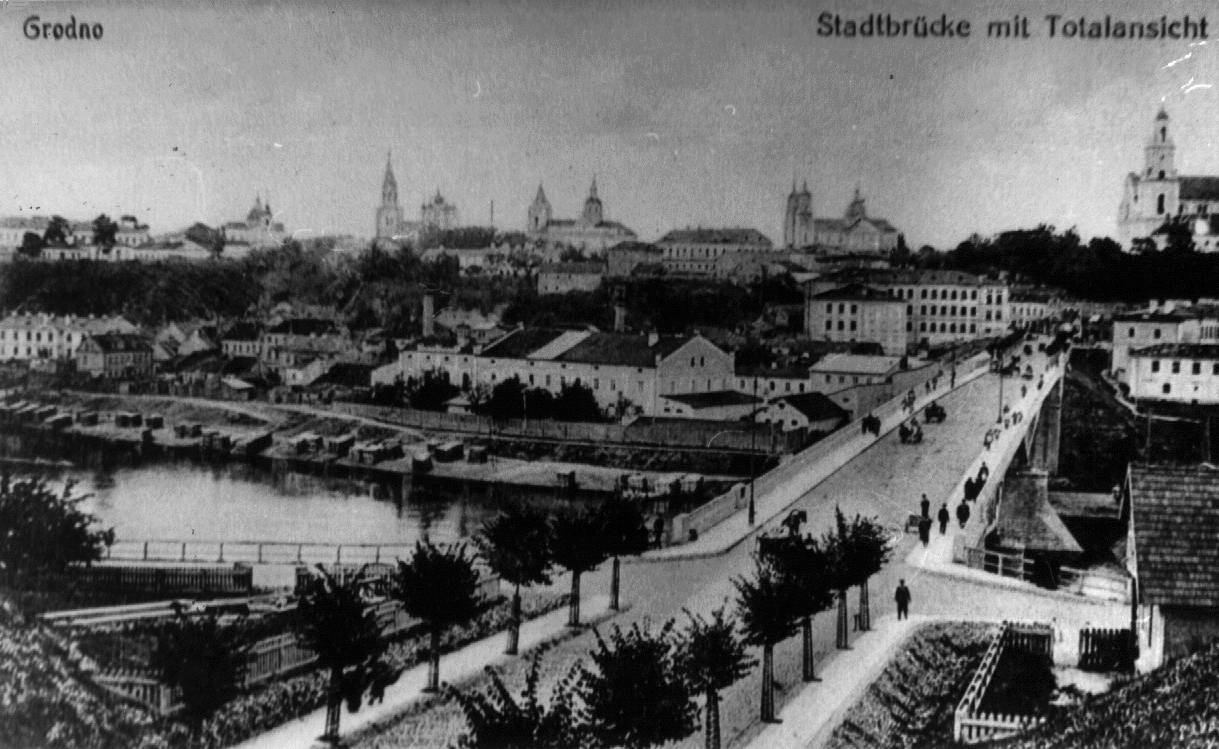  The New Castle in Grodno used to be a summer residence of Polish–Lithuanian Commonwealth monarchs.A 16th-century view of Grodno The New Castle in Grodno used to be a summer residence of Polish–Lithuanian Commonwealth monarchs.A 16th-century view of Grodno: upload.wikimedia.org/wikipedia/commons/6/63/View_of_Grodno_in_1575.PNGTo aid the reconstruction of trade and commerce, the grand dukes allowed the creation of a Jewish commune in 1389. It was one of the first Jewish communities in the grand duchy. In 1441 the city received its charter, based on the Magdeburg Law. After the First Partition of the Polish–Lithuanian Commonwealth, Grodno became the capital of the short-lived Grodno Voivodeship in 1793. As an important centre of trade, commerce, and culture, Grodno remained one of the places where the Sejms were held. Also, the Old and New Castles were often visited by the Commonwealth monarchs including famous Stephen Báthory of Poland who made a royal residence here. In 1793 the last Sejm in the history of the Commonwealth occurred at Grodno. Two years afterwards, in 1795, Russia obtained the city in the Third Partition of Poland. It was in the New Castle on November 25 of that year that the last Polish king and Lithuanian grand duke Stanisław August Poniatowski abdicated. In the Russian Empire, the city continued to serve its role as a seat of Grodno Governorate since 1801. The industrial activities, started in the late 18th century by Antoni Tyzenhaus, continued to develop. Up to the Second World War and the Holocaust, like many other cities in Europe, Hrodna ( Grodno) had a significant Jewish population: according to Russian census of 1897, out of the total population of 46,900, Jews constituted 22,700 (so around 48% percent). World War IAfter the outbreak of World War I, Grodno was occupied by Germany (1915) and ceded by Bolshevist Russia under the Treaty of Brest-Litovsk in 1918. After the war the German government permitted a short-lived state to be set up there, the first one with a Belarusian name - the Belarusian National Republic. This declared its independence from Russia in March 1918 in Minsk (known at that time as Mensk), but then the BNR's Rada (Council) had to leave Minsk and fled to Grodno. All this time the military authority in the city remained in German hands. After the outbreak of the Polish-Bolshevik War, the German commanders of the Ober Ost feared that the city might fall to Soviet Russia, so on April 27, 1919 they passed authority to Poland. The city was taken over by the Polish Army the following day and Polish administration was established in the city. The city was lost to the Red Army on July 20, 1920 in what became known as the First Battle of Grodno. The city was also claimed by the Lithuanian government, after it was agreed by the Soviet-Lithuanian Treaty of 1920 signed on July 12, 1920 in Moscow that the city would be transferred to Lithuania. However, Soviet defeat in the Battle of Warsaw made these plans obsolete, and Lithuanian authority was never established in the city. Instead, the Red Army organised its last stand in the city and the Battle of Neman took place there. On September 23 the Polish Army recaptured the city. After the Peace Treaty of Riga, Grodno remained in Poland. Initially, prosperity was reduced due to the fact that the city remained only the capital of a powiat, while the capital of the voivodship was moved to Białystok. However, in the late 1920s the city became one of the biggest Polish Army garrisons. This brought the local economy back on track. Also, the city was a notable centre of Jewish culture, with roughly 37% of the city's population being Jewish. World War IIDuring the Polish Defensive War of 1939 the garrison of Grodno was mostly used for the creation of numerous military units fighting against the invading Wehrmacht. In the course of the Soviet invasion of Poland initiated on September 17, there was heavy fighting in the city between Soviet and improvised Polish forces, composed mostly of march battalions and volunteers. In the course of the Battle of Grodno ( September 20–September 22), the Red Army lost some hundred men (by the Polish sources; by the Soviet sources - 57 killed and 159 wounded) and also 19 tanks and 4 APCs destroyed or damaged. The Polish side suffered at least 100 killed in action, military and civil, but losses still remain uncertain in detail (Soviet sources claim 644 killed and 1543 captives with many guns and machine guns etc. captured). Many more were shot in mass executions after being imprisoned. After the engaged Polish units were surrounded, the remaining units withdrew to Lithuania. In accordance with the Molotov-Ribbentrop Pact the city was transferred to the Belarusian SSR of the Soviet Union, and several thousand of the city's Polish inhabitants were deported to remote areas of the Soviet Union. On June 23, 1941 the city came under German occupation that lasted until 16 July 1944. In the course of World War II, the majority of Hrodna's remaining Jews were exterminated in German concentration camps. Being the part of extended East Prussia Grodno was renamed by Germans to Garten (meaning " garden") in 1942. Since 1945 the city has been a centre of one of provinces of the Belarusian SSR, now of the independent Republic of Belarus. The majority of Poles were expelled or run away to Poland 1944-1946 and 1955-1959. Polish wiki: pl.wikipedia.org/wiki/Grodno
|
|
|
|
Post by pjotr on Feb 18, 2013 19:06:40 GMT 1
Vilnius dispute
Vilnius dispute, Vilnius also spelled Wilno, post-World War I conflict between Poland and Lithuania over possession of the city of Vilnius (Wilno) and its surrounding region.
Although the new Lithuanian government established itself at Vilnius in late 1918, it evacuated the city when Soviet forces moved in on Jan. 5, 1919. A few months later Polish forces drove the Red Army out of Vilnius and occupied it themselves (April 20, 1919). The Lithuanians rejected the demands of the Polish chief of state, Józef Piłsudski, for union with Poland, and hostilities were avoided only by the Allies’ creation of a demarcation line (the Foch Line) to separate the armies of the two countries; Vilnius was left on the Polish side of the line. In the summer of 1920, however, the Red Army reoccupied Vilnius, and on July 12 Soviet Russia ceded the city to Lithuania. Subsequently, violence broke out between Lithuania and Poland. The League of Nations arranged a partial armistice (Oct. 7, 1920) that put Vilnius under Lithuanian control and called for negotiations to settle all the border disputes. Two days later the Polish general Lucjan Żeligowski drove the Lithuanian troops out, proclaimed the independence of central Lithuania, and established its government at Vilnius. For the next year and a half, negotiations continued under the aegis of the League of Nations, which finally abandoned its role as mediator on Jan. 13, 1922.
Five days earlier, however, General Żeligowski, again prompted by Piłsudski, called for elections for a regional Diet, which on February 20 voted to incorporate central Lithuania into Poland. That arrangement was later accepted by the League’s council, which set the border almost along the Foch Line (Feb. 3, 1923)—a decision that was confirmed on March 15 by the conference of ambassadors of the Allied Powers. Lithuania, however, rejected the settlement and, on the basis of the continuing Vilnius dispute, refused to arrange regular diplomatic relations with Poland. Only in 1938, under the pressure of a Polish ultimatum (issued March 17), did Lithuania agree to receive a Polish representative. Vilnius was restored to Lithuania on Oct. 10, 1939.
|
|
|
|
Post by pjotr on Feb 18, 2013 19:07:23 GMT 1
Wilno (Vilnius) Vilnius Vilnius, Russian Vilnyus, Polish Wilno, Russian (formerly) Vilna, city, capital of Lithuania, at the confluence of the Neris (Russian Viliya) and Vilnia rivers. A settlement existed on the site in the 10th century, and the first documentary reference to it dates from 1128. In 1323 the town became capital of Lithuania under Grand Duke Gediminas; it was destroyed in 1377 by the Teutonic Knights. Subsequently rebuilt, Vilnius received its charter of self-government in 1387, and a Roman Catholic bishopric was established there. The town and its trade flourished and grew; in 1525 a printing press was set up, and in 1579 a Jesuit academy was opened. The city underwent many calamities— Russian occupation in 1655–60, Swedish capture in 1702 and 1706, French occupation in 1812, and recurrent fires and plagues. In 1795 Vilnius passed to Russia in the Third Partition of Poland. It was occupied by the Germans in World Wars I and II and suffered heavy damage. From 1920 to 1939 it was included in Poland; it was taken by Soviet troops in 1939 and restored to Lithuania. The Soviets annexed Lithuania, including Vilnius, in June 1940. Soviet rule brought mass deportations (1940–41, 1946–50) of ethnic Lithuanians from Vilnius, and many Russians moved into the city. In 1970 the population of Vilnius was 43 percent ethnically Lithuanian (up from 34 percent in 1959) and 18 percent Polish. In 1991 Vilnius again became the capital of independent Lithuania. A prominent feature of the city before World War II was its Jewish community, for nearly 150 years the centre of eastern European Jewish cultural life. Traceable as far back as 1568, this community comprised 20 percent of the city’s population by the middle of the 17th century. In the 18th century, under the influence of Rabbi Elijah ben Solomon, it underwent a decisive religious and spiritual growth, becoming renowned for rabbinical studies that between 1799 and 1938 produced texts of the Mishna, Jerusalem Talmud, and other works that are still standard. In the 19th century the community became a centre for the Haskala ( Enlightenment) and was the home also of the first Jewish socialists in Russia; by the beginning of the 20th century it had become the focus of the Zionist movement in Russia as well. A flourishing source of Hebrew and Yiddish literature, with numerous newspapers and literary, scientific, and cultural periodicals, it was the birthplace of the YIVO Institute for Jewish Research (founded 1924). The German occupation during World War II destroyed the community, reducing the city’s Jewish population from 80,000 in 1941 to 6,000 by 1945. 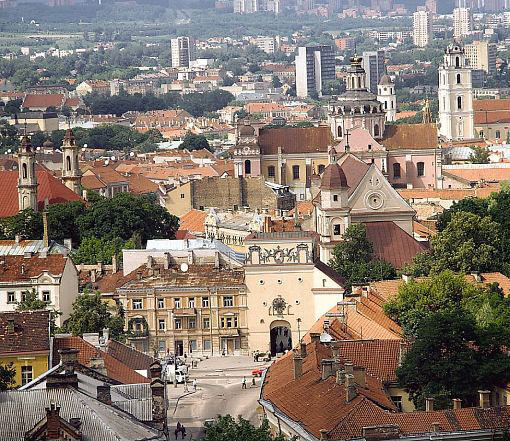 Many historic buildings survive, representing the Gothic, Renaissance, Baroque, and classical styles of architecture. The ruins of the Castle of Gediminas on Castle Hill dominate the old town, with its narrow, winding streets that climb the wooded slopes surrounding the confluence of the rivers. There are a 16th-century Gothic Church of St. Anne and a dozen 17th-century Baroque churches, notably the Church of SS. Peter and Paul. The cathedral dates originally from 1387, but in its present form from 1801. Around the old town are the newer sectors of the city, with a rectangular street plan, large apartment blocks, administrative buildings, and modern factories. The historic centre of Vilnius was designated a UNESCO World Heritage site in 1994.  Upper Castle Vilnius Upper Castle Vilnius  The ruins of the Castle of Gediminas on Castle Hill dominate the old town, with its narrow, winding streets that climb the wooded slopes surrounding the confluence of the rivers. The ruins of the Castle of Gediminas on Castle Hill dominate the old town, with its narrow, winding streets that climb the wooded slopes surrounding the confluence of the rivers. Present-day Vilnius is an important industrial centre, producing machine tools, agricultural machinery, electronic calculators and other electrical and electronic apparatus, textiles, clothing, and foodstuffs. The city is the cultural centre of Lithuania. The V. Kapsukas State University is the successor to the Jesuit academy of 1579, and the Vilnius Civil Engineering Institute was founded in 1969. There are institutes of fine arts and teacher-training schools and several theatres and museums. The art gallery occupies the former town hall, built in the 18th century. Pop. (2008 prelim.) 544,206.  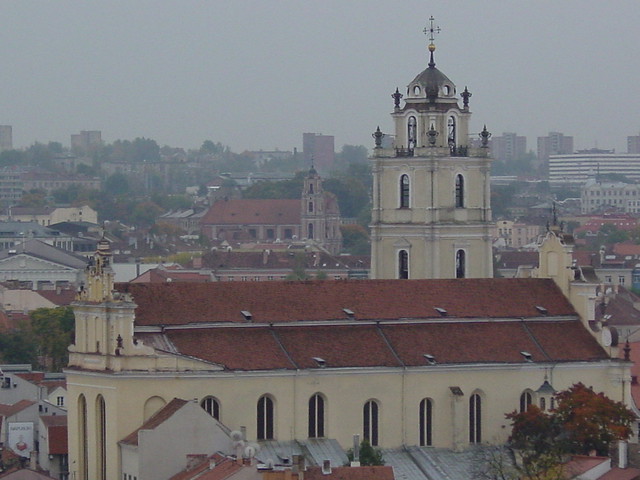 St.Johns' Church from Gediminas Castle St.Johns' Church from Gediminas Castle  Lithuanians wanted their independence when they were stil under Sovjet rule Lithuanians wanted their independence when they were stil under Sovjet rule
|
|
|
|
Post by pjotr on Feb 18, 2013 19:08:53 GMT 1
Bonobo and Tufta, Have you ever been to Vilnius and what was your opinion, experiance and feeling when you visited this city, which was so important to Poland as Wino and so important to the Luthuanians as Vilnius, their capital. I know about the historical and recent tensions and incidents between Lithuanians and Poles inside Lithuania and the strained diplomatic and political ties between Poland and Lithuania as a result of that. On the other Forum (Jaga's Forum) Kaima (Kai) sees the it like this: I would hardly - I would not - recognize Vilnius from the one picture of the high rises! I spent half of 1993 living there and all of the tall highrise buildings shown have been built in the 20 years that have intervened in that time. I am amazed. My sympathies are far more with the Lithuanians than with the Poles when it comes to the historic dispute of "ownership" of Vilnius. It is definitely Lithuanian. The Poles were simply colonists who moved in and were the majority citizens of the city. To my mind that does not make it Polish. Certainly by that standard we could declare El Paso a Mexican city, parts of New York City a Israeli city (with one of the biggest populations of Jews of any city in the world) and give other parts of the city to Puerto Ricans. Miami could belong to Cuba, and what would we do with Black sections of our large cities, declare them "Ethnically Independent"? A new Polish-Lithuanian union would have been interesting, but I doubt the Lithuanians wanted to give up Russian domination for Polish domination. Kai My reply to his opinion and the fact that he spend half a year in Vilnius (therefor he has more knowledge, experiance and practical information about Vilnius than I have, because I have never been there): Kai, Maybe you recognise this old part of Vilnius from the time you were there in 1993? ( look under my written reply to you) It must have been wonderful to spend a half year in this beautiful old Baltic, Lithuanian city, with it's multi-cultural past with Polish, German, Jewish, Russian and Tartar influences next to the Lithuanian ones. Like Warsaw Modernity, democracy, freedom, free market/free enterprise, Internet (e-commerce), trade, industrial production and innovative industries have made Vilnius a prosperous city. Present-day Vilnius is the major economic centre of Lithuania and one of the largest financial centres of the Baltic states ( Lithuania, Latvia and Estonia). Vilnius is an important industrial centre, producing machine tools, agricultural machinery, electronic calculators and other electrical and electronic apparatus, textiles, clothing, and foodstuffs. Even though it is home to only 15% of Lithuania's population, it generates approximately 25% of Lithuania's GDP. Vilnius contributed over 10,015 billion litas to the national budget in 2008. That makes about 37% of the budget. Currently in Vilnius there are growing local advanced solar and laser technologies manufacturers centres (such as photovoltaic elements and renewable energy producers: Arginta, Precizika, Baltic Solar), high performance lasers manufacturers: Ekspla, Eksma, biotechnological manufacturers (Fermentas Thermo Fisher, Sicor Biotech), which successfully supply their products into global markets. In 2009, the Barclays Technology Centre was established in Vilnius, which is one of four strategic engineering global centres. I understand why your sympathies are far more with the Lithuanians than with the Poles when it comes to the historic dispute of " ownership" of Vilnius. First, from historical perspective and secondly as a Slovak you have no Polish connection to Lithuania. To Vilnius you have a connection, because you lived there for half a years in that post-Sovjet era, just two years after the bloody independence struggle. You have no connection to the Polish Wilno of 1920-1939, because you are on the Lithuanian independence side. That's understandable. I think differently. I think differently. Not political correct, not ethical or moral, but practical how it was. Vilnius is definitely Lithuanian today. From 1920 until 1939 it was Polish. Before that it was part of the Russian Czarist empire, and for a short period German during th First World War. From 1941 until 1944 it was German again, and after that from 1944 until 1991 part of the SovjetUnion, as the Lithuanian Sovjet Republic. To say simply that the Poles were simply colonists who moved in and were the majority citizens of the city is to simplistic in my view. You had a shared Polish-Lithuanian Common Wealth, and in all Baltics states and in Belarus there were Polish minorities. And example of that is the family of my Polish grandfather, who were ethnic (Roman-Catholic) Poles who were settled in Eastern-Poland, but had a past in the Baltic states. (My grandfather and his father, my great grandfather were born and raised in Talinn, the capital of Estonia, but my mother told me that I/we have probably some Lithuanian blood [roots]. I can't proof that, but that were the rumors). There was both Polish and German gentry (nobility) in the Baltic states (Prussian junkers and Polish schlachtza) next to the Baltic Germans and the Polish populations in the Baltic states and Belarus. You have to understand that it was the time of the Partititions, and Poland and Lithuania didn't exist. Poles moved, worked and lived in Russia too. If you read novels of Gogol, you reed about Polish merchants and farmers -who go to a market- on Saint Petersburg streets. I am certainly not political correct and do feel connected to the name, existance and period that the city Vilnius was the Polish city Wilno. The same is with the Dutch Indies and South-Africa. It is political incorrect due to colonialism, Apartheid and etc. to feel connected to those places, but due to that fact a lot of Indonesians and Indo-Europeans live in the Netherlands and when I am in South-Africa I can speak Dutch to White and Colored people who speak Afrikaans, because (with some difficulty) I can understand Afrikaans. I feel connected to the Afrikaner ( Boers) people due to their Dutch roots, religion ( Calvinism, very known to me), the fact that a lot of them look Dutch ethnically (although they are a mix of Dutch, German and French settlers in the 17th century). I hate racism and Apartheid, but I don't hate Afrikaners. The same with Lithuania. Maybe the Poles treated the Lithuanians badly, but the Lithuanians treated the Poles badly back. And in contrast with the Poles I will never forget the role of the Lithuanians and other Baltic people in the Holocaust. They were not so nice to the jews either. I agree with you that Lithuanians will never give up their indepedance for again Polish domination or Russian domination. But a new Polish-Lithuanian union could be interesting, if the other Baltic states, Belarus and the Ukraine would like to join. And in that perspective I would think more of a regional Baltic-Slav alliance or Union in staid of a Polish dominated Union. In that perspective I think about alliances like the cooperation between the Scandinavian countries, the Benelux, the Weimar Triangle and the Visgrad Group. Cooperation between these states, but with the autonomy of the Independent states. No country or state today should accept the dominance or imperialism of other states. We live in a different world now. Last thing I would like to say about Vilnius when it was Wilno in the Interbellum period. Under the rule of Jozef Pilsudski (1926-1935) there was religious and cultural tolerance for minorities in Poland like Lithuanians, Russians, Urkainains, Germans, jews and Belarussians. Piłsudski's Sanacja regime began a period of national stabilization and of improvement in the situation of ethnic minorities, which formed about a third of the Second Republic's population. Piłsudski replaced the National Democrats' " ethnic-assimilation" with a " state-assimilation" policy: citizens were judged not by their ethnicity but by their loyalty to the state. Eastern Orthodox, Greek Orthodox, Protestant, Judaic and Islamic organizations, praising Piłsudski for his policies of religious tolerance. Mainstream organizations of ethnic minorities similarly expressed their support for his policies of ethnic tolerance, though he was criticized by, in addition to the Polish communists, by the (socialist) Jewish Labour Bund, and by Ukrainian, German and Lithuanian extremists. Cheers, Pieter Vilnius Old Town The Old Town of Vilnius ( Lithuanian: Vilniaus senamiestis), one of the largest surviving medieval old towns in Central Europe, has an area of 3.59 square kilometres ( 887 acres). It encompasses 74 quarters, with 70 streets and lanes numbering 1487 buildings with a total floor area of 1,497,000 square meters. The oldest part of the Lithuanian capital of Vilnius ( Wilno), it has developed over the course of many centuries, and has been shaped by the city's history and a constantly changing cultural influence. It is a place where some of Europe's greatest architectural styles - gothic, renaissance, baroque and neoclassical - stand side by side and complement each other. Pilies Street is the Old Town's main artery and the hub of cafe and street market life. The main street of Vilnius, Gediminas Avenue, is partially located in the Old Town. The central squares in the Old Town are the Cathedral Square and the Town Hall Square.  Pilies Street in the Old Town of Vilnius Pilies Street in the Old Town of Vilnius Vilnius Cathedral Square Vilnius Cathedral Square The Cathedral Square The Cathedral Square The Town Hall Square of Vilnius The Town Hall Square of Vilnius The Town Hall Square of Vilnius The Town Hall Square of VilniusOne of the most elaborate architectural complexes is the Vilnius University Architectural Ensemble, which occupies a large part of the Old Town and has 13 courtyards. It was selected to represent Lithuania in the Mini-Europe Park in Brussels. In 1994 the Vilnius Old Town was included in the UNESCO World Heritage List ( No. 541) in recognition of its universal value and originality. The definition of " historic center" itself has a broader meaning than the Old Town, formerly encircled with defensive walls. It embraces the valuable historical suburbs of Vilnius, such as Užupis, which historically used to be outside the city boundaries. Therefore Užupis is often considered a part of the Old Town of Vilnius.  An independent republic in the middle of a city? With its own president, constitution and Independence Day?! Welcome to Užupis, a district of Vilnius Old Town – beloved home for many artists, celebrities, politicians and even religious prophets! Užupis is often compared to Montmartre in Paris, with its citizens, their lifestyle and beliefs all contributing to the cosy neighbourhood feel of Vilnius. An independent republic in the middle of a city? With its own president, constitution and Independence Day?! Welcome to Užupis, a district of Vilnius Old Town – beloved home for many artists, celebrities, politicians and even religious prophets! Užupis is often compared to Montmartre in Paris, with its citizens, their lifestyle and beliefs all contributing to the cosy neighbourhood feel of Vilnius.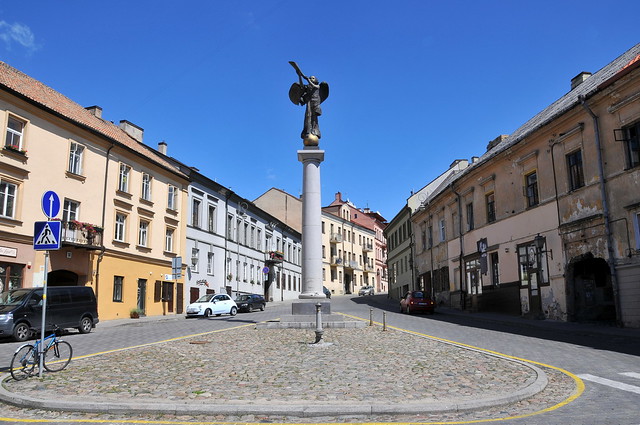 The Angel of Užupis' VilniusFor 13 years in the row, the citizens of Užupis have declared their district the Independent Republic of Užupis. This picture was taken this year (2010) on April 1st – April Fools’ Day – the official unofficial Independence Day of the Republic of Užupis. Every year the citizens of Užupis organise a celebration for themselves and invite everybody to party together. You can be a student, an ambassador of a foreign country, a farmer or a business man. Whether you’re single or with the family, everybody’s welcome to join the feast. The Angel of Užupis' VilniusFor 13 years in the row, the citizens of Užupis have declared their district the Independent Republic of Užupis. This picture was taken this year (2010) on April 1st – April Fools’ Day – the official unofficial Independence Day of the Republic of Užupis. Every year the citizens of Užupis organise a celebration for themselves and invite everybody to party together. You can be a student, an ambassador of a foreign country, a farmer or a business man. Whether you’re single or with the family, everybody’s welcome to join the feast.
In Užupis, numerous art and socially responsible activities take place all year round, including various shows, the release of live fish to the Vilnelė River, white table cloth day when families bring food left over from the Easter feast and share it with others, or voluntarily cleaning up the neighbourhood. All activities culminate in one huge celebration on April 1st.
With its original constitution, Užupis declares no boundaries for personal – or even animal – self-expression, nor for rights and responsibilities. For example, article no. 36 states that Everyone has the right to be personal, while article no. 12 declares that A dog has the right to be a dog.
A new tradition for newlyweds has also evolved over recent years – walking across any bridge to Užupis and putting a padlock on its railings – a symbol of strong commitment and locked-in happiness.
Whatever time of year you visit Lithuania and Vilnius, do not miss the chance to take a tour of the Republic of Užupis and lock your heart on Užupis, stroll through peaceful streets of our beloved Vilnius, pop into yards, visit many spectacular churches or simply relax in oustanding cafés. Young citizens of Užupis looking like Arnhem Art academy students ( Young citizens of Užupis looking like Arnhem Art academy students (  ;D ;D  ), or young people with an Indie (Independent) life stile with their New Wave or Punk look. Užupis reminds me of the free town or colony of creative people, Christiana in Copenhagen. ), or young people with an Indie (Independent) life stile with their New Wave or Punk look. Užupis reminds me of the free town or colony of creative people, Christiana in Copenhagen. ( en.wikipedia.org/wiki/Freetown_Christiania / pl.wikipedia.org/wiki/Christiania_(dzielnica_Kopenhagi) )  The gallery "GALERA" is the place where artists can exhibit their pictures for free. This gallery is part of the Art Incubator, located in Užupis (Vilnius Monmartre). The gallery "GALERA" is the place where artists can exhibit their pictures for free. This gallery is part of the Art Incubator, located in Užupis (Vilnius Monmartre). ( www.daumantas.eu/index.php?option=com_content&view=article&id=12:galera-2008-en&catid=11:photography&Itemid=11 ) LandmarksThere are more monuments of interest in the Old Town than in any other part of Vilnius; they include: PalacesVilnius Old Town Presidential Palace Presidential Palace Slushko Palace Slushko Palace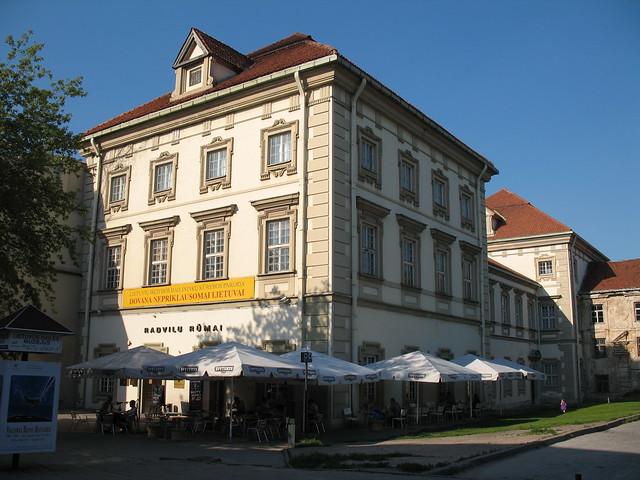 Radvilu Palace Radvilu Palace Tyzenhaus PalaceReligious monuments Tyzenhaus PalaceReligious monuments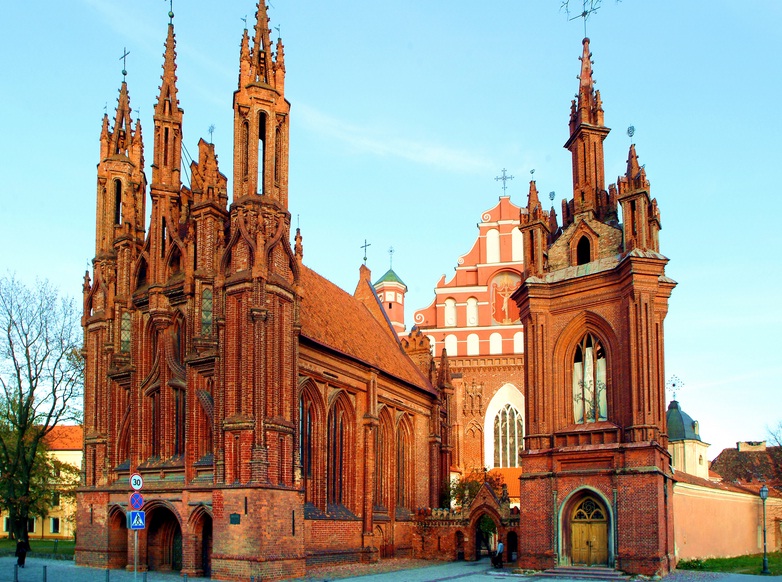 St. Anne's Church St. Anne's Church Vilnius Cathedral in Cathedral Square Vilnius Cathedral in Cathedral Square Russian Orthodox St. Nicholas Church Russian Orthodox St. Nicholas Church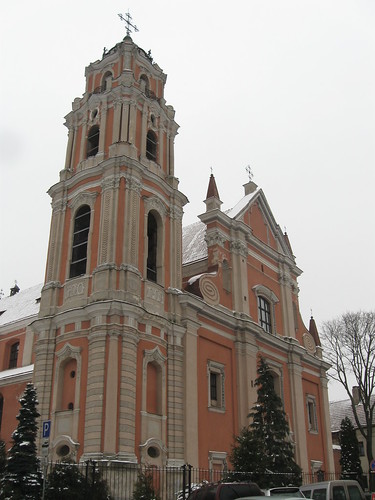 All Saints Church All Saints Church The interior of the All Saints Chruch The interior of the All Saints Chruch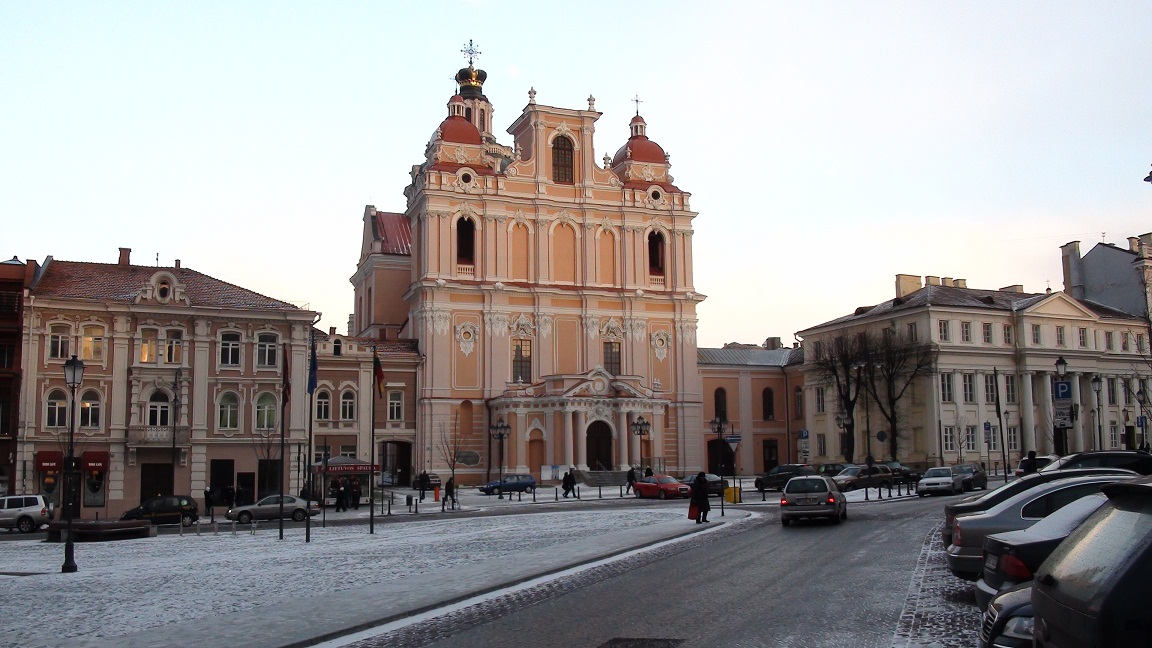 Baroque Saint Casimir church (1616) in the Rotušės square. (Saint Nicholas Russian Orthodox church once looked much more western until Russian Empire rebuilt it in its showcase neo-Byzantic style (mid-19th century). Today it is probably the most beautiful among Russian Orthodox churches of Vilnius.) Baroque Saint Casimir church (1616) in the Rotušės square. (Saint Nicholas Russian Orthodox church once looked much more western until Russian Empire rebuilt it in its showcase neo-Byzantic style (mid-19th century). Today it is probably the most beautiful among Russian Orthodox churches of Vilnius.)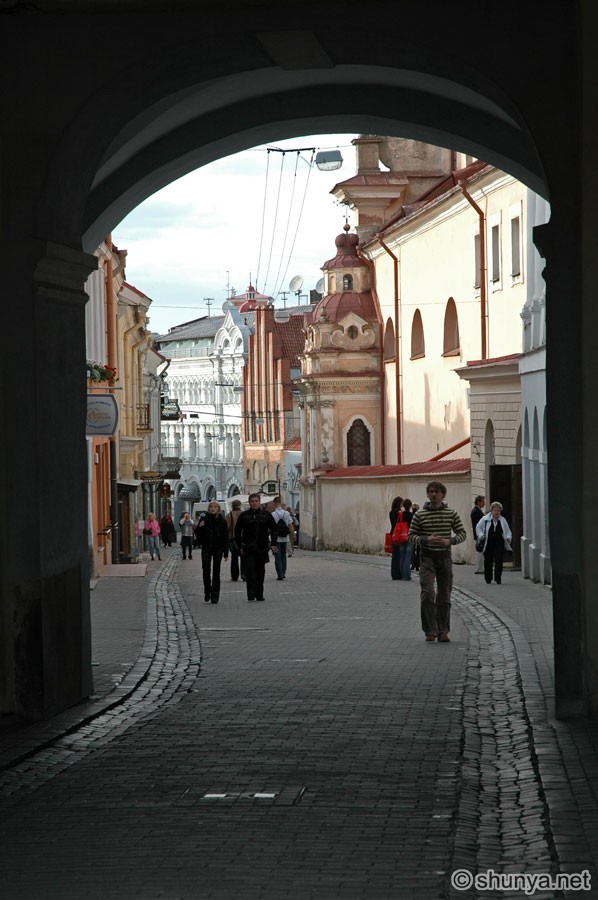 Gate of Dawn in Vilnius Gate of Dawn in Vilnius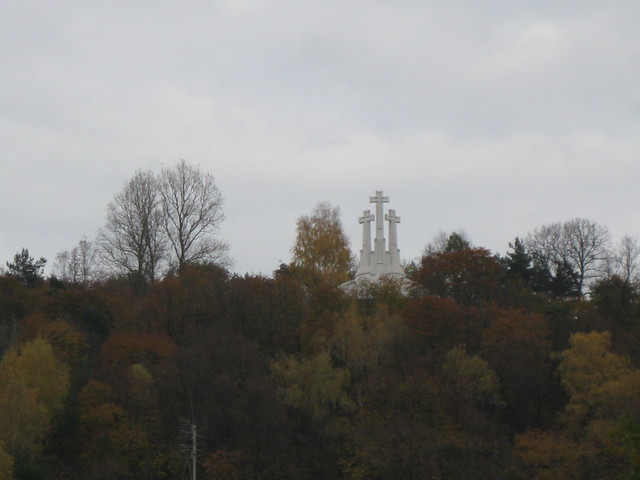 Hill of Three Crosses: Visible from various locations in Vilnius, the three white crosses commemorate legendary martyrs. The Hill of Three Crosses is a part of a larger park area that preserves the historic wilderness of Lithuania. It’s a great spot for a picnic or to simply get away from exhaust and noise of the city streets. It’s especially beautiful in the autumn. Hill of Three Crosses: Visible from various locations in Vilnius, the three white crosses commemorate legendary martyrs. The Hill of Three Crosses is a part of a larger park area that preserves the historic wilderness of Lithuania. It’s a great spot for a picnic or to simply get away from exhaust and noise of the city streets. It’s especially beautiful in the autumn. 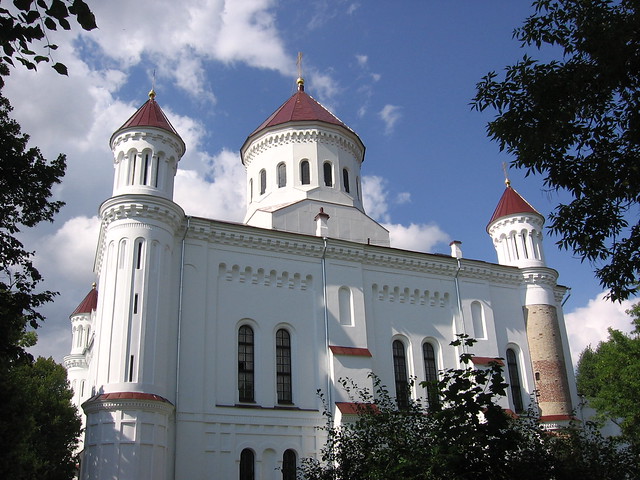 Cathedral of the Theotokos Cathedral of the Theotokos Sinagogue of Vilnius Sinagogue of Vilnius The interior of the sinagogue of Vilnius The interior of the sinagogue of Vilnius A Karaite Kenesa in Vilnius. The Karaim are a Jewish sect who migrated to Lithuania from the Crimea to serve as a military elite unit in the 14th century. Although their numbers are very small, the Karaim are becoming more prominent since Lithuanian independence, and have restored their kenesa. Kenesa is the term for a Karaite or Persian synagogue. The word derives from the Aramaic word for "assembly" (in Hebrew, the word for synagogue is beit knesset). A Karaite Kenesa in Vilnius. The Karaim are a Jewish sect who migrated to Lithuania from the Crimea to serve as a military elite unit in the 14th century. Although their numbers are very small, the Karaim are becoming more prominent since Lithuanian independence, and have restored their kenesa. Kenesa is the term for a Karaite or Persian synagogue. The word derives from the Aramaic word for "assembly" (in Hebrew, the word for synagogue is beit knesset). Back view of the Kenesa in VilniusKaraites Back view of the Kenesa in VilniusKaraites still exist today, about 10,000 of them living in or near Ramla, outside Tel Aviv–Yafo, and small enclaves survive in Poland, Lithuania and Russia. Their liturgy is less rich than that of other Jewish congregations, having little poetry but many readings of scriptural texts. ( In Poland, Karaites are a recognized minority, represented by the Association of Polish Karaites (Polish: Związek Karaimów Polskich) and the Karaite Religious Association in the Polish Republic (Polish: Karaimskiego Związku Religijnego w Rzeczypospolitej Polskiej). Karaites live primarily in and around Warsaw, Wrocław and Tricity, they are linguistically assimilated. )  The Nemėžis mosque in Vilnius district is an example of little wooden Tatar mosques. You can find in Poland also. The town Nemėžis itself was established by Tatars in the 15th century, and today is situated right on the administrative border with Vilnius city. The town is mostly inhabited by Tatars or descendants of them. The Nemėžis mosque in Vilnius district is an example of little wooden Tatar mosques. You can find in Poland also. The town Nemėžis itself was established by Tatars in the 15th century, and today is situated right on the administrative border with Vilnius city. The town is mostly inhabited by Tatars or descendants of them. Currently there are 4 mosques in Lithuania. Unfortunately some old mosques like in Vilnius, Biržai, Panevėžys, Trakai and other places were destroyed by the soviet communist authorities. 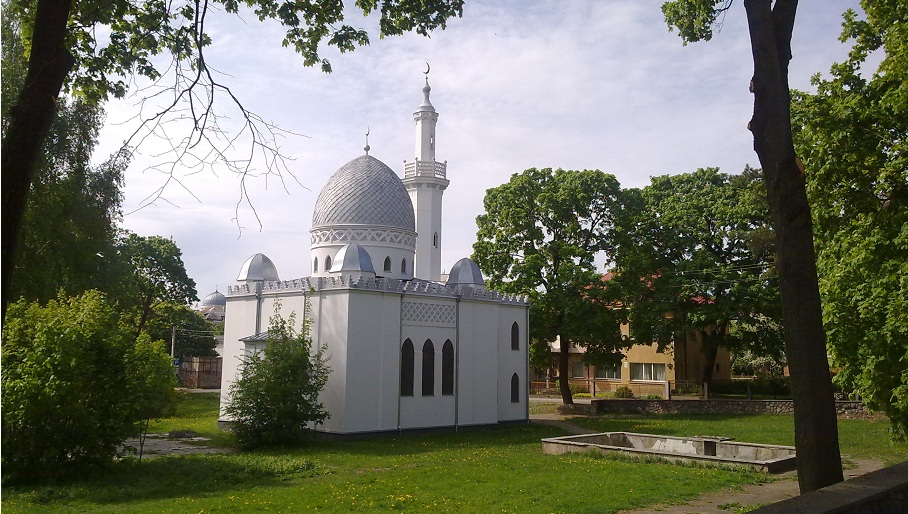 The Kaunas mosque, currently the only stone mosque in Lithuania.Other places of interest The Kaunas mosque, currently the only stone mosque in Lithuania.Other places of interest The House of the Signatories (This house represents place where the declaration of Independence of 1918 was signed by Lithuanian politicians, between when was the most important and famous Jonas Basanavicius (shown on 50 Litai banknote too)) The House of the Signatories (This house represents place where the declaration of Independence of 1918 was signed by Lithuanian politicians, between when was the most important and famous Jonas Basanavicius (shown on 50 Litai banknote too)) National Museum of Lithuania National Museum of Lithuania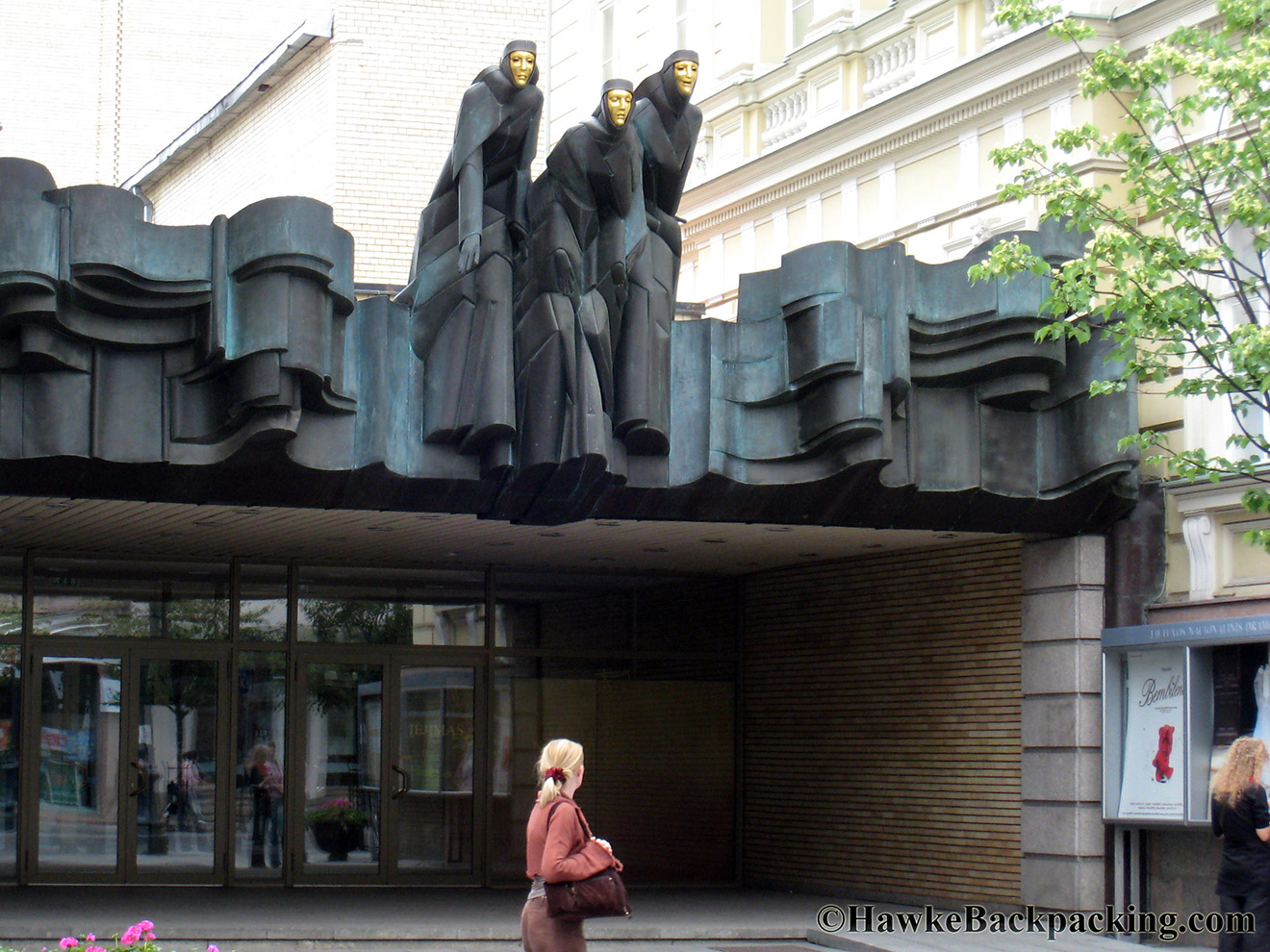 Lithuanian National Drama Theatre Lithuanian National Drama Theatre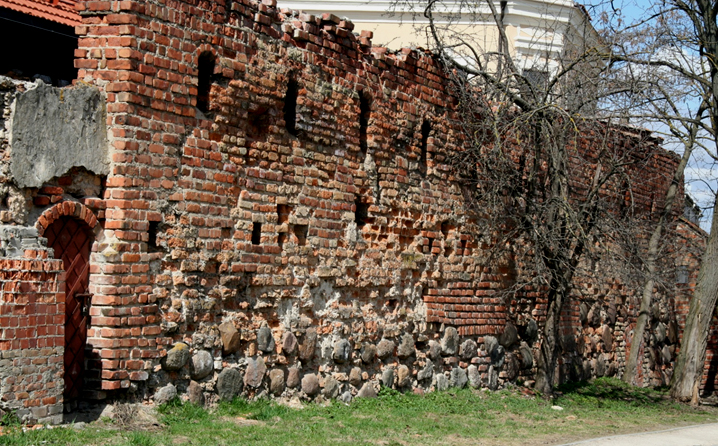 Fragments of the Vilnius city wall (The old city wall originates from the 1500s.) Fragments of the Vilnius city wall (The old city wall originates from the 1500s.) Vilnius dungeons ( The Vilnius Dungeons are medieval dungeons under parts of the downtown of Vilnius. Their real size and extent, as well as purpose and age, are arguable; there are some urban legends and various theories about these dungeons. In the dungeons, there are about 4000 dead bodies. Due to the dry climate inside, many of them have naturally mummified, others are just skeletons. ) Vilnius dungeons ( The Vilnius Dungeons are medieval dungeons under parts of the downtown of Vilnius. Their real size and extent, as well as purpose and age, are arguable; there are some urban legends and various theories about these dungeons. In the dungeons, there are about 4000 dead bodies. Due to the dry climate inside, many of them have naturally mummified, others are just skeletons. ) Funeral ceremony of the heart of Polish president J. Pilsudski passes the Rotušės square in Wilno in 1935. Like many Polish-speaking people of Lithuanian descent of the era J. Pilsudski called himself a Lithuanian but did not believe in independent Lithuania. He sought to establish a large country that would encompass Poland, Ukraine, Lithuania and Belarus, and would use Polish as lingua franca. His dreams were behind the annexation of Vilnius region to Poland in 1922.www.novavita.lt/program-tour.htmvilnews.com/?p=9805 Funeral ceremony of the heart of Polish president J. Pilsudski passes the Rotušės square in Wilno in 1935. Like many Polish-speaking people of Lithuanian descent of the era J. Pilsudski called himself a Lithuanian but did not believe in independent Lithuania. He sought to establish a large country that would encompass Poland, Ukraine, Lithuania and Belarus, and would use Polish as lingua franca. His dreams were behind the annexation of Vilnius region to Poland in 1922.www.novavita.lt/program-tour.htmvilnews.com/?p=9805 |
|
|
|
Post by pjotr on Feb 18, 2013 20:19:04 GMT 1
Marshal Pilsudski's funeral
Jozef Pilsudski died of liver cancer (they are talking about materials gastric cancer with metastasis to the liver) at Warsaw's Belweder Palace on May 12, 1935 (the ninth anniversary of the coup d'etat), at 20.45. His funeral was a great manifestation of national unity. National mourning was announced.
On May 13, 1935 his brain and heart were removed from the body. The brain has been studied by scientists in Vilnius (Wilno) - after the study was published in a limited edition summarizing the first stage of the work published (Brain Jozef Pilsudski). On 17 May Funeral Mass was celebrated by Cardinal Alexander Kakowski.
Marshall's body laid in the crypt of St. Leonard Castle in Kraków's Wawel Cathedral. For a time, however, lasting dispute between the authorities of the clergy and laity of the resting place of Pilsudski. Finally, June 22, 1937, by order of Archbishop of Krakow, by Archbishop Adam Stefan Sapieha, the coffin was transferred to the crypt Marshal for Silver Bells Tower.
Jozef Pilsudski's heart was interred in his mother's grave at Vilnius' Rasos Cemetery, where it remains.
|
|
|
|
Post by tufta on Feb 18, 2013 21:03:24 GMT 1
Hi Pieter! I have been to Wilno and liked the city very much. Poles, Belarusians, Ukrainians and Lithuanians have a great common past behind, they have formed a unique, democratic, liberal state (comparatively to European 'norm' at that time) which ruled over some one fifth of Europe and provided her 'Eastern flank' stability for some 400 years. Unfortunately Ukrainians were not treated as a full-rights member in this state, and that btw was one of the reasons of it's spectacular failure. Please note that when I mention those different nationalities and theri unique Europe-wide rights, nationalities as we understand this word today, I am talking about 'haves' or nobility. The peasants of that time, though the most numerous were not 'citizens' and had no rights, which were regulated and reserved for szlachta. Making a simplification - it is somewhat the same as when we talk about Ancient Rome and the Roman Empire, we mean 'haves', the citizens, not the 'non-haves', slaves etc. Having that in mind no nobles of Rzeczpospolita, apart from Malorusian (in today's meaning: Ukrainian) had a reason to complain, regardless their ethnic background, they had all the rights and representations. Peasants - yes, very much so, had reasons to complain as they were not free. Today's Lithuania is a nation formed from the peasants of Litwa, they are still learning to appreciate their great past as represented by Lithuanian noblemen -szlachta. Somewhat similar situation is with Slovakia - they are the nation formed from Slavic peasants of Slovakia- a region of Hungarian Kingdom. Brave and different but just one of many minorities of Hungary. Thus a natural, fully understandable sympathy between the two. Coming back to your question - yes I have been to Wilno and several times. Talked with Poles and Lithuanians. I can say that the latter are now on the express path to overcome past complexes, and become proud of our common past, to accept the historical past as past, both wrong and good. One sign of this overcoming, considering the tensions of last two-three years, is the apology by Lithuanian foreign affairs minister while visiting Poland a few days back, for some devaiations to the accepted rules of neighbourhood agreed in Polish-Lithuanian treaty from the year 1994. I remember all that was reported in the forum by Bo, Kresy too. I teh future of Poland and Lithuania, future of Lithuanian Vilnius, very brightly - inside EU or even outside EU if you guys inside the Eurozone won't at last come with the solution to the crisis   Lithuanian Vilnius of today is as unique a city as Wroc³aw, former German city of Breslau, where common, mixed history is very much palpable, beating. Even more so in Vilnius, as many Poles still live there, and around they city. What is done with this beat is totally to us - contemporary people. I am an optimist. |
|
|
|
Post by tufta on Feb 18, 2013 21:08:46 GMT 1
Great photos btw!
I feel tempted to post my own from Lithuania, though I am not sure if that is in concord with our fine host's plans for the forum.
|
|
|
|
Post by pjotr on Feb 18, 2013 22:06:49 GMT 1
Great photos btw! I feel tempted to post my own from Lithuania, though I am not sure if that is in concord with our fine host's plans for the forum. I would like it if you did! (Even if afterwards they would be replaced to a photosection, called Photo's of Lithuania, part of Kresy theme ;D   |
|
|
|
Post by Bonobo on Feb 19, 2013 0:00:47 GMT 1
Wow, Peter, amazing effort put into this thread! I am really impressed.
No, I have never been to Vilno or Lvov. Somehow, I am a domestic guy, I travel in Poland only.
As for nostalgic feelings for those ones Polish lands, I have none. Today they are Lithuania, Belarus and Ukraine. Their Polish chapter has been closed (except for Polish minority, of course).
|
|
|
|
Post by pjotr on Feb 19, 2013 1:00:38 GMT 1
Hello Tufta, It is good that you have visited that wonderful city Wilno several times. It is always good to know your neighbors and your own past, which are often related to eachother. And Wilno or Vilnius has a lot of shared Polish-Lithuanian history. Like you so correctly mentioned and I refered to in mentioning Pilsudski's ideology and regime, the The Polish–Lithuanian Commonwealth (1569–1795) bound the two nations together, and made Wilno one of it's great cities. The earliest writings about the city date back to the 12th century. The town became famous after Gediminas, the ruling Grand Duke in 1316, invited German merchants to come to the city. Władysław II Jagiello ( King of Poland, Grand Duke of Lithuania) granted the town city rights in 1387. In later centuries the town continued to grow, partly because a university was founded in 1579 by King Stephen Báthory, King of Poland ( 1576–1586). Stephen Báthory is considered to be one of the most illustrious elected kings of the Polish-Lithuanian Commonwealth. The first university in the grand duchy of Lithuania soon became an important scientific and cultural center. Lithuania before the The Polish–Lithuanian CommonwealthThe grand duchy of Lithuania, state, incorporating Lithuania proper, Belorussia, and the western Ukraine, became one of the most influential powers in eastern Europe ( 14th–16th century). Pressed by the crusading Teutonic and Livonian Knights, the Lithuanian tribes united under Mindaugas (d. 1263) and formed a strong, cohesive grand duchy during the reign of Gediminas ( reigned 1316–41), who extended their frontiers across the upper Dvina River in the northeast to the Dnieper River in the southeast and to the Pripet Marshes in the south. After Gediminas’ death, two of his sons succeeded him: Kęstutis ruled Lithuania proper, preventing territorial encroachments from the German knights and their allies, while Algirdas, the titular grand duke, continued his father’s expansionist policies and, by conquering vast Russian and Tatar territories, stretched his domain from the Baltic to the Black Sea. Influenced greatly by their Russian subjects, the Lithuanians not only reorganized their army, government administration, and legal and financial systems on Russian models but also allowed the Russian nobility to retain its Orthodox religion, its privileges, and its local authority. The Lithuanians, however, also remained involved with their western neighbours; in 1385, under pressure from the hostile Teutonic Knights, the grand duke Jogaila ( reigned 1377–1434) concluded a pact with Poland ( Union of Krewo), agreeing to accept the Roman Catholic faith, marry the Polish queen, become king of Poland, and unite Poland and Lithuania under a single ruler. Jogaila took the Polish name Władysław II Jagiełło. Polish influence subsequently began to replace Russian influence in Lithuania. The grand duchy, however, retained its autonomy, and, under the rule of Vytautas, Jogaila’s cousin and former political rival, who was named viceroy in 1392, it expanded to the Ugra and Oka rivers in the east, assumed a dominant role in Tatar and east Russian political affairs, and became the most powerful state in eastern Europe. In 1410 Lithuania, led by Vytautas, also joined Poland and decisively defeated the Teutonic Knights ( Battle of Tannenberg). As a result, it gained control of the northwestern territory of Samogitia (confirmed in 1422) and permanently reduced the German threat to Lithuania. Back to your experiances and very interesting reply Tufta; It is in that historical perspective and the fact that there is so much Polish history there a very good thing that you have been to Wilno so many times. I know a Dutch architect from Arnhem who loves the Baltic states and Lithuania very much. He had been there several times, and he likes Wilno and the mix of Lithuanian, Polish and Russian culture there. He is a person who isn't fond of Southern-Europe like most North-West-Europeans. He loves Scandinavia and the Baltic states, because it is cooler there. I think he travelled there during autumn and in the wintertime, because during the summer it can be hot in Lithuania and Wilno. Polish roots, Polish history, Polish landmarks (architecture of buildings, churches, pallaces and castles) and Polish settlement (the Poles that stayed and formed minorities there) are visible in Belarus, Ukraine and Lithuania. The Polish minorities have it difficult in these states sometimes due to the Nationalism of the Ukrainian, Belarussian and Lithuanian nationalists and sometimes oppressive government policies .(a good example is Belarus, which has authorities which are hostile to the Polish minority and Poland. The Belarussian leader and his regime are a typical remnant of Sovjet times and Pro-Moscow) The Ukrainian-Polish relationship in the past was not so good, partly due to what you described: " Unfortunately Ukrainians were not treated as a full-rights member in this state, and that btw was one of the reasons of it's spectacular failure. Please note that when I mention those different nationalities and theri unique Europe-wide rights, nationalities as we understand this word today, I am talking about 'haves' or nobility. The peasants of that time, though the most numerous were not 'citizens' and had no rights, which were regulated and reserved for szlachta." Fortunately Polish-Ukrainian relations have improved, but both Poles and Ukrainians will not forget the past. And Poland and the Poles also considerably suffered under Ukrainian war crimes and opression, by Ukrainian Nazi collaborators (Rona brigade in Warsaw, Ukrainian SS and Ukrainian Kapo's in concentration camps which abused and murdered Polish Roman-Catholics and Polish-Jews), the Ukrainain resistance movement, the Ukrainian Insurgent Army ( UPA) ( pl.wikipedia.org/wiki/Ukraińska_Powstańcza_Armia ), and ofcourse members of the Urkainian Sovjet partisans and Ukrainian NKVD members. (the Sovjets were not only Russian, but also Ukrainian and Belarussian) In present day Ukraine I have the impression that Western-Ukraine is more Ukrainain feeling and Ukrainian Patriotic and democratic in the sense of Pro-European membership, Ukrainian independance from Moscow and supporter of the Orange revolution, and that Eastern-Ukraine, with a large Russian minority is Pro-Russian and less Western oriented. So Ukraine is a complicated country to me. The present president Viktor Yanukovych is a mystery to me, having a Pro-Moscow, Eastern-Ukrainian past. Yanukovych is not ethnically Ukrainian, but rather of Russian, Polish, and Belarusian descent. Yanukovych is a surname of Belarusian origin; Yanuk being a derivative of the Catholic name Yan (“ John”). His mother was a Russian nurse, who died when Yanukovych was two years old, and his father was a Polish-Belarusian locomotive driver, originally from Yanuki, Vitsebsk Voblast. By the time he was a teenager, Yanukovych had lost both his parents and was brought up by his Polish paternal grandmother, originally from Warsaw. His grandfather and great-grandparents were Lithuanian-Poles. Yanukovych has half-sisters from his father's remarriage, but he has no contact with them. ( pl.wikipedia.org/wiki/Wiktor_Janukowicz ) He was in my perspective on the wrong side of Ukrainian politics (not the Viktor Andriyovych Yushchenko and Yulia Tymoshenko Orange revolution side; which was actively supported by Poland). What is good and noble is the fact that Poland has actively supported and campaigned for Ukrainian membership of the EU and NATO (like Poland also stood behind Georgia, an historical allie -rember the Georgians that fought on Polands side againts the Sovjets in the 1920 Polish-Sovjet war - Poles, Belarusians, Ukrainians and Lithuanians have a great common past behind, but unfortunately I doubt if that is reason enough to unite them. In reality nationalism, personal interests of countries and the power of the greater Slav Brother (Russia) is often more important or dominant than the advice, comradeship and best intensions of the other more wise brother. (Poland) The work of Polish diplomats, politicians (Polish European parlaimentarians), presidents, prime-ministers and ministers of foreign affairs has been good for Ukraine, but I don't know if the political ballance in Ukraine is positive towards Poland. Poland invested in Ukraine when Ukrainian allies were in power. After that the power ballance changed and the pro-Moscow wing of the Ukrainian parlaiment gained power. I said that I don't trust president Viktor Yanukovych, who looks and acts like an old Sovjet leader like Leonid Brezhnev, but I don't trust his prime-minister, Mykola Yanovych Azarov, either. Azarov was born in Kaluga in the Russian SFSR, Soviet Union, to half Estonian, half Russian. Azarov speaks Ukrainian poorly. In a 11 March 2010 article the UK daily The Guardian labelled him the most Russophile member of the new cabinet. pl.wikipedia.org/wiki/Mykoła_AzarowIt is an interesting thesis to state that today's Lithuania is a nation formed from the peasants of Litwa, and that they are still learning to appreciate their great past as represented by Lithuanian noblemen -szlachta. And that Slovak woud feel connected to Lithuanians, because Slovakia, was a nation from Slavic peasants. That created the natural bond, and mutual affaction between the Slovaks and Lithuanians (Now I understand the opinion from Kaima, the Slovak-American from Alaska, who kept ties with his relatives in Slovakia and the Czech republic, and who spend half a year in Wilno in 1993). It is interesting Tuft, that you had the chance to talk with Poles and Lithuanians in Wilno. Often discussions with various ethnic, cultural, religious and political groups in an area with historical break lines, places with blood in the ground and filled with tension, can be difficult, sometimes dangerous or complicated and embarrassing. In my own city I have felt the very tense and sometimes explosive relationship and coexistance for instance of migrant communities of Turkish and Turkish-Kurd backgrounds. Both Turkish Ultra-nationalism (sometimes nearly entering a fascistoid tendency) and Kurd nationalist seperatism (and extremism) can block any reasonable discussion. The discussion is about Turkish territory, which is in the same time part of Kurdistan. In the same sense it would be difficult to start a discussion between German Heimatvertriebenen from Western-Poland (former Germany) and Sudetenland and Poles and Czechs. Maybe the same counts for Ukrainian war crimes against Poles. Tens of thousands of Poles were exterminated by the Ukrainian insergent army UPA, and we never heard of that in Western-Europe, nor from Polish sources. How are Poland and Ukraine dealing with that shared past in the light of the better Polish-Ukrainian relations of today? Did the Poles forgive the Ukrainians, or is it like with Germany? The present generation of Germans and Ukrainians is disconnected to the war crimes of their ancesters. Often the murderers were their great-great grandfathers. And not every German and Ukrainian had ancesters that participated in the war crimes agains the Poles. History is a complicated matter. It is good to hear from you that the Lithuanians are now on the express path to overcome past complexes, and become proud of our common past. To accept the historical past as past, both wrong and good is always a first good step to reconcile with one another, to heal the shared wounds of the past and to look into the present and the future. What do we have in common. We share such a long history. Hundreds of years of alliance and Union. The Poles and Lithuanians share kings, grand dukes, great writers, artists and poets. The apology by Lithuanian foreign affairs minister while visiting Poland a few days back is very, very good. It is a noble thing he did. I hope that vice versa Lithuanians that were and are visiting Poland were and are treaded good. (I remember a Polish lady cursing Baltic truckdrivers in Warsaw during my stay there. But maybe that is a common thing amongst neighbours, like Dutch people can sometimes make remarks about German or Belgian number plate wearing cars) It is nice that you see the future of Poland and Lithuania, the future of Lithuanian Vilnius, very brightly - inside the EU or even outside the EU-. We people inside the EU can not agree on many things, so the Euro is no exception. Inside the Eurozone there isn't enough courage and charisma of the leaders to come with wise solutions to the crisis. They quarrel and quarrel. And the Euro-sceptic or anti-European forces seem to be strong, although a minority. Great-Britain threatening to leave, Germany fed up with Southern-Europe, France, Spain and Italy involved and struggling with their own internal economical and financial crisis. Sometimes it seems that only the Polish economy is thriving or on the right stabile course. (I would advice the Poles to stay out of the Eurozone as long as they can. Look what the enter of the Eurozone brought the Slovaks, the collapse of the Slovakian economy. I say: " Polish products are good, but cheaper than other European products due to the lower value of the Zloty, when the Poles join the Euro, that benefit is lost and the Polish import & export business, production, trade and the Polish financial market [the Warsaw stock exchange] will suffer from it". I say: " If Poland joins the Eurozone to quickly, that will not benefit the Polish economy", and I say " It is rediculous to regard the Eurozone as the Walhalla, it is just an artificially constructed monetarian union between states. There is nothing wrong with the Polish Zloty, the British pound and the Danish krone". But in the same time I say: " I am not an economist, nor a financial analyst, and certainly not an expert on the Polish economy and the Polish internal market -as being part of the greater European continental innermarket-." It was just my personal opinion, from the news sources I read. Warsaw Business journal is one of them. It is good that many Poles still live in Vilnius (Wilno), and around the city. I hope that they are able to coexist with their Lithuanian compatriots in peace and prosperity. I like your optimism. Cheers, Pieter www.britannica.com/EBchecked/topic/612921/Ukraine/30063/Lithuanian-and-Polish-rule#ref404402 |
|
|
|
Post by pjotr on Feb 19, 2013 2:03:46 GMT 1
Wow, Peter, amazing effort put into this thread! I am really impressed. Thank you, this research for content and images that are connected to that content took me a lot of time, but it seems that that fact connects me to Polish history, culture and reality. No, I have never been to Vilno or Lvov. Somehow, I am a domestic guy, I travel in Poland only. There is nothing wrong with that, because Poland has a lot to offer. Different landscapes, from the East-sea coast to the Tatra mountains, from the Mazury lake district to Western Poland. Lot's of wonderful cities, towns and villages. (I am curious for Poland. The experiances in the seventees, eightees and 2004 and 2006 haven't left my mind. I am connected to Poland by those memories. Poland lives in me due to these experiances. And like Tufta correctly said: I can return. Sometimes I am too stuck to this part of Europe, due to my job, social life and like your statement about Poland: " There is a lot to do in the Netherlands, and I don't even know all parts of the Netherlands yet." But that is no excuse. I have to see more of both Poland and the Netherlands. I have a sort of Bruno Schulz attitude: When I lived in Vlissingen the first 20 years of my life, I spend most of my time extensively on the Walcheren Peninsula where Vlissingen was located, when I lived two years in Amsterdam after that, I spend all of my time and concentration there, after Amsterdam -you can guess- I studied, lived and worked in Arnhem for more than 22 years now, and I have spend most of my time here. Arnhem is my Drohobycz.  ;D  ) As for nostalgic feelings for those ones Polish lands, I have none. Today they are Lithuania, Belarus and Ukraine. Their Polish chapter has been closed (except for Polish minority, of course). Bonobo, You are a real Polish pragmatist. A realist who thinks from the present situation. I am a Diaspora person, and one of those old Romantic types, I am infected by the pre-war mindset and thinking of old family members of both the Polish and Dutch family branches. I can't help it. I am in the twilight zone between old Poland and new Poland. The Interbellum lives in me. But in the same time I am part of the Modern media and connected to the present younger generations. I have a fondness of Central-Europe in general, a fondness of a territory which is larger than Poland, but in my sense connected to Poland. I am fond of Prague (the city where the brother of my Polish grandfather studied ) and fond of Budapest. (and again there is a historical connection. From the Hungarian king of Poland Stephen Báthory [27 September 1533 – 12 December 1586] to the year of 1956 -Poznań & Budapest-) But to me Krakow lies in line with Prague and Budapest as former Habsburg (The Austrian-Hungarian empire) cities. I felt at home in all of these three cities. Cities which are different from on another, but who share their Central-European location, interesting past, and multi-layers of history.
I have a lot of Polish cities, towns and regions to visit in the near future. I am more of a city trip guy than a country man. But I do enjoy lakes, mountains and rivers. Water is always vital and important to me. I don't like dry area's, except the South-African and West-Coast (Arizona) deserts I saw.
Because cities show history, the architecture, infrastructure, people to observe, dynamism, culture, fine art, book stores grand café's, pubs, Museums, art galleries, Old Towns and New City centre's with Modern architecture, that I like. I like the layers of history what make up a town or city, the organic growing beings, which cities are.
Poland is a great country, because it has much interesting cities and towns.
Cheers,
Pieter |
|
|
|
Post by tufta on Feb 19, 2013 9:09:50 GMT 1
Wow, Peter, amazing effort put into this thread! I am really impressed. Thank you, this research for content and images that are connected to that content took me a lot of time, but it seems that that fact connects me to Polish history, culture and reality. May I on this occassion express my appreciation for Bonobo's constant, perseverant, stubborn, truly Krakovian! effort. Keep up the good job, Bo  |
|
|
|
Post by tufta on Feb 19, 2013 9:11:28 GMT 1
I will then put some up temporarily later on.
|
|
|
|
Post by pjotr on Feb 19, 2013 15:17:59 GMT 1
Thank you, this research for content and images that are connected to that content took me a lot of time, but it seems that that fact connects me to Polish history, culture and reality. May I on this occassion express my appreciation for Bonobo's constant, perseverant, stubborn, truly Krakovian! effort. Keep up the good job, Bo  Tufta, I approve this message!  ;D  |
|
|
|
Post by Bonobo on Feb 19, 2013 21:45:31 GMT 1
May I on this occassion express my appreciation for Bonobo's constant, perseverant, stubborn, truly Krakovian! effort. Keep up the good job, Bo  Tufta, I approve this message!  ;D  Guus, you are being such good boys. Have you done some mischievous act and now you are trying to pacify me? PS. Tufta, I hope you don`t mind having your photos moved to Our Own Photos section. It is here now: polandsite.proboards.com/index.cgi?board=historypoland&action=display&thread=2760&page=1 |
|
|
|
Post by Bonobo on Feb 19, 2013 22:34:01 GMT 1
Bonobo, You are a real Polish pragmatist. A realist who thinks from the present situation. I am a Diaspora person, and one of those old Romantic types, I am infected by the pre-war mindset and thinking of old family members of both the Polish and Dutch family branches. I can't help it. I am in the twilight zone between old Poland and new Poland. The Interbellum lives in me. But in the same time I am part of the Modern media and connected to the present younger generations. Pieter Peter, my father`s family comes from Lithuania. My great grandfather had some land property there. But WW2 turned everything upside down. When at high school in 1980s, we sang anticommunist songs like:
Jedna bombka atomowa i wrócimy znów do Lwowa
Druga bombka, ale silna. I wrócimy te¿ do Wilna
One atom bomb and we`ll come back to Lwow
Another bomb, strong one, we`ll come back to Wilno, too. But that was meant as a protest against the Soviet Union. Today, they are independent countries. We live today, too. |
|
|
|
Post by pjotr on Feb 20, 2013 0:23:46 GMT 1
I agree with you Bo, all those annaxed cities and towns by Ukraine, Belarus, Lithuania and Poland (the German territories and cities/towns), shoud stay Ukrainian (Lviv), Belarussian (Hrodno), Lithuanian (Vilnius), and Polish ( Szczecin, Świnoujście and Wrocław) should stay Ukrainian, Belarussian, Lithuanian and Polish. Germany respects the Oder-Neisse border, and Poland respects the border with Ukraine, Belarus and Lithuania.
|
|
|
|
Post by polkanakresach on Mar 26, 2013 7:59:08 GMT 1
Hello Everyone! I invite you to the virtual tour of western Ukraine, through the eyes of the one Polish woman, who is living now in Kresy. You will find lots of pictures (how it looks now) from different cities and villages... polkanakresach.blogspot.com
|
|
|
|
Post by pjotr on Mar 26, 2013 9:45:47 GMT 1
Polkanakresach,
I like your blog very much with the wonderful images of 'Polish' Roman-Catholic churches in Belarus and the wonderful Greek-Catholic and Orthodox churches and sinagogues. I can't read Polish, but I can enjoy the images and via them understand the context.
Cheers,
Pieter
|
|
|
|
Post by polkanakresach on Mar 27, 2013 8:53:46 GMT 1
I am very happy that you like my blog  If you wish to translate the subtitles and read what I wrote there- you can do this by choosing your language in the Google Translate (upper left corner, under the title picture - above my description), and then all entries will be in your language  ) Cheers, polkanakresach |
|
|
|
Post by tufta on Mar 27, 2013 9:31:00 GMT 1
Hello, witam serdecznie!  I took a look into your blog, liked it and will study it in more detail when time permits Loved the photo  You have arrived in this forum in a somewhat unfortunate time, since it's owner is absent polandsite.proboards.com/index.cgi?action=display&board=forum&thread=2668&page=1#26937We try to fill in for him somehow but it is not the same. What is more he's interested in the architecture and Orthodox culture - he made a trip around SE Poland and documented many Orthodox churches - the photos must be around here somewhere. Witaj! |
|
|
|
Post by polkanakresach on Mar 27, 2013 11:44:20 GMT 1
Serdecznie witam! Made me very happy that You like my blog! On this pictured is a wooden Greek Catholic Church of the Resurrection of Christ from the village Voskresyntsi (near Kolomyya) I do not worry about the owner of the forum is unavailable, I did not turn up here only for him  I'm here for all forum users  A blog also conducting for people who would like to see these areas and for various reasons they can not do it. This can be a family which once lived here a long time ago (people born here, their children, grandchildren or great-grandchildren), or people which they are interested these places. Maybe someone thanks to this pictures will decide to come to see these places with their own eyes?  Pozdrawiam  |
|
|
|
Post by polkanakresach on Mar 31, 2013 19:54:34 GMT 1
Happy Easter Everyone!!!
|
|
|
|
Post by propatriapoland on Jan 28, 2019 15:24:23 GMT 1
Cemetery of the Defenders (Eaglets) of Lwów / Lvov / Lviv
A brief description of the Lyczakowski Cemetery and the Cemetery of Eaglets in Lwów.
he Cemetery of the Defenders of Lwów (Polish: Cmentarz Obrońców Lwowa, Cmentarz Orląt, Cemetery of Eaglets, Orlat Cemetery) is a memorial and a burial place for the Poles and their allies who died in Lviv (Polish: Lwów) during the hostilities of the Polish-Ukrainian War and Polish-Soviet War between 1918 and 1920.
The complex is a part of the city's historic Lychakiv Cemetery. There are about 3000 graves in that part of the cemetery; some from the Lwów Eaglets young militia volunteers, after whom that part of the cemetery is named. It was one of the most famous necropolises of the interwar Poland.
|
|
|
|
Post by Bonobo on Jan 28, 2019 22:12:29 GMT 1
Cemetery of the Defenders (Eaglets) of Lwów / Lvov / Lviv A brief description of the Lyczakowski Cemetery and the Cemetery of Eaglets in Lwów. Nice film. I watched it all and I have two remarks: - you could have included the photos of the time when the cemetery was ruined during communist times and of its restoration later on. - you mention the wooden boxes which cover the statues of lions, but you don`t explain why. Let me only suggest looking through this thread with the photos of the cemetery. polandsite.proboards.com/thread/5711/polish-military-cemetery-lvov |
|
|
|
Post by propatriapoland on Jan 29, 2019 10:15:57 GMT 1
Thanks for the suggestions. You're right. For me it was obvious and It was one of my first films.
|
|
|
|
Post by propatriapoland on Nov 16, 2020 8:53:14 GMT 1
Defense of Lviv 1918.
|
|















































 ;D
;D  ), or young people with an Indie (Independent) life stile with their New Wave or Punk look. Užupis reminds me of the free town or colony of creative people, Christiana in Copenhagen. (
), or young people with an Indie (Independent) life stile with their New Wave or Punk look. Užupis reminds me of the free town or colony of creative people, Christiana in Copenhagen. ( 





























